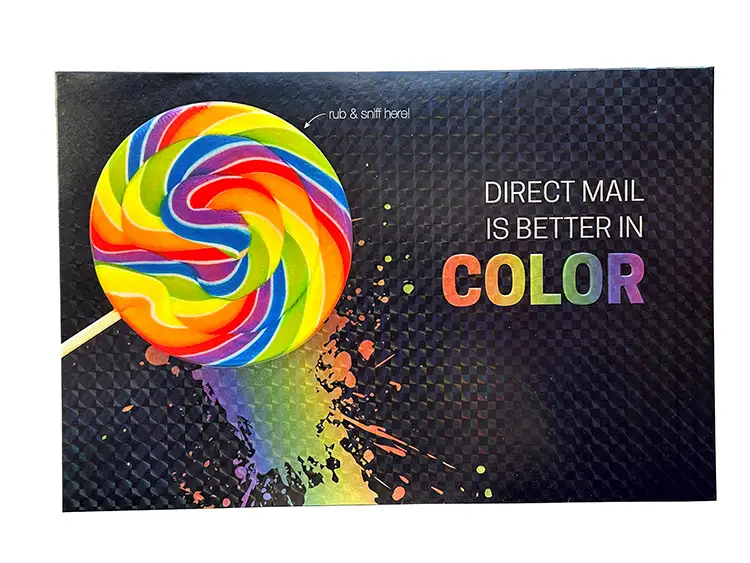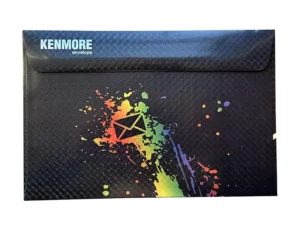
By Jeff Peterson, editor-in-chief, PostPress
Kenmore Envelope Company, located in Richmond, Virginia, specializes in high-end envelope manufacturing, which includes everything from the printing and finishes to the final envelope converting. Special finishes and embellishments always have been an important part of what Kenmore offers.
To showcase Kenmore’s abilities, the company believes creating specialty embellished envelope samples for its customers and prospects is an important part of the selling process. In a recent envelope design, the Kenmore team decided it wanted to highlight ‘scent’ coating with its newest sample creation.
“We had a meeting with about a dozen Kenmore team members to throw around ideas and came up with the lollipop idea,” said Scott Evans, Kenmore Envelope president. “From there, we discussed how to make each embellishment impactful and not only shine by itself, but as a whole to the entire design.”
The goal was to have a cutting-edge envelope to showcase the technological investments Kenmore offers without getting too busy with the look and design.
The Kenmore team wanted the colors of the lollipop to pop off the envelope design. Once the flat art was created, the team needed to determine what to add to improve the existing design with Kenmore’s available embellishments – which effects to combine, where to place the embellishments, and what design elements on the envelope to highlight.
 The lollipop envelope includes cold foil transfer, 4-color process, Cast & Cure™ clear holographic and spot scent coating that smells exactly like a lollipop. The amazing aspect of the project is that the embellishment and finishes all were accomplished in two passes. The cold foil and 4-color process printing was the first pass, and the Cast & Cure and scent coating were applied in the second pass. All of these were done on a K+B Rapida 106 LED UV offset press with an Eagle Systems’ cold foil module. The final steps in the production were the embossing of the word ‘Color’ and the lollipop on the front side of the envelope and the diecutting. Both were accomplished in one pass on Kenmore’s in-house platen 40″ diecutter. The final envelope was converted on a W+D 628.
The lollipop envelope includes cold foil transfer, 4-color process, Cast & Cure™ clear holographic and spot scent coating that smells exactly like a lollipop. The amazing aspect of the project is that the embellishment and finishes all were accomplished in two passes. The cold foil and 4-color process printing was the first pass, and the Cast & Cure and scent coating were applied in the second pass. All of these were done on a K+B Rapida 106 LED UV offset press with an Eagle Systems’ cold foil module. The final steps in the production were the embossing of the word ‘Color’ and the lollipop on the front side of the envelope and the diecutting. Both were accomplished in one pass on Kenmore’s in-house platen 40″ diecutter. The final envelope was converted on a W+D 628.
The envelope included a silver cold foil in specific areas of the envelope and then the 4-color process was applied inline for the vivid, colorful lollipop and the black background of the envelope. There also was overprinting CMYK over the silver cold foil in the ‘splash’ below the lollipop and the word ‘COLOR’ in the headline. The next pass applied the Cast & Cure film on the black background to showcase a clear holographic pattern over the entire envelope except over the printed lollipop. The Cast & Cure process was applied through Eagle Systems’ cold foil module for the second pass. The scented spot coating then was applied over the lollipop on one of the offset stations inline with the Cast & Cure. Lastly, the wording ‘COLOR’ and the lollipop were embossed in the final pass.
“We limited the amount of cold foil so we didn’t overwhelm the envelope as there’s beauty in having focused cold foil in certain areas,” explained Evans. “The combination of the cold foil and embossing also had a beautiful impact.”
The cold foil used for the lollipop envelope was supplied by Univacco, the Cast & Cure film was supplied by Breit Technologies and the scented scratch-off coating came from Scentisphere.
Kenmore Envelope strongly believes that tailored envelopes have a higher chance of being opened than ones that lack distinction. Clients have shared with Kenmore that the specialty embellishments increase their lift vs. a non-embellished envelope, including feedback from clients that the increase has been three to five times more than in previous non-embellished envelopes.
“I believe our clients and the agencies we have worked with for years have always challenged us about what’s new and next. What can differentiate them from their competitors?” Evans said. “There’s a luxury feel to being a bit different and to stand out.”
The cover of this issue of PostPress was produced by Kenmore Envelope Company, which supplied the covers through the inspiration of the lollipop envelope project.

